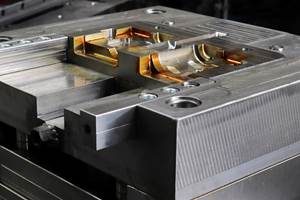A Look at Mold Texturing
Laser texturing, if understood and appreciated, can open up the door to endless possibilities in texturing, according to this texture house.
Share
Randy Peslar of Wisconsin Engraving/ Unitex, and who also teaches a texturing certification course at MoldTrax, shared with me his thoughts on laser mold texturing.
“The use of lasers in texturing has opened the door to endless possibilities. Although lasers have been used for cutting and welding for a while, it’s only been about 10years since lasers started being used for texturing molds. It took some time to develop the software for the machines to deliver the required fineness and to create soft yet extravagant textures with consistent but varying depths.
Lasers excel here. For example, a texture with four different printed levels, each with a different depth being etched with acid could have a max depth of 0.0055 of an inch with its shallowest depth being only 0.0005 of an inch. This takes many steps with acid, but with a laser the texture is done all at once, saving you time while giving you consistent quality throughout the textured mold. I have seen 8x6-inch molded parts that look and feel fantastic with animal, geometric and stipple-like grains.
With laser texturing the parting lines are kept pure from any kind of human interaction. This is because the tools are textured from the data supplied from the moldmaker. The acid etching process requires that the parting lines be protected at all times. This entails masking them with a special tape and/or a paint. Rolled edges and undercuts will result If the parting lines are not taken care of properly.
However, there are problems that still need to be addressed. For one, the investment for the machines is very high, limiting a shop’s ability to purchase the required size and number of machines. This means only certain tools can be designated for laser texture because a shop may not have the number of machines or a machine big enough to facilitate laser texturing the tooling to meet the OEM’s delivery expectations.
Customer Texture Requirements
Automotive companies are always looking for something new and exciting, so they want textures that can draw a person into the products they are selling. Texture makes products look strong, sexy, tough and rugged or even fragile via geometric, functional, leather, stipple, animal and wood textures.
Most texture houses can replicate each other’s grains, but there seems to be a common misconception. A customer will ask, “What is your version of a ‘specific’ OEM grain?” The answer is, “It is the same as our competitors.” For example, a GMGF oo1 Brazil texture is not known by any other name. OEMs use textures that are specifically designed for them and shouldn’t be used for any other companies or brands. Although they don’t own the textures, they are to be used for those OEMs only. The spec is the type of header on the print and a number/letter or name. When a mold shop is directed to use a specific texture house or an AAR (Appearance Approval Report) is given to use a specific texture house, the tool shop must comply. Also, when someone calls out a UT (Wisconsin Engraving/ Unitex) or an MT (Mold-Tech) grain spec, the customer isn’t being forced to use a specific texture house, so they don’t need to cross reference the specified grain. Texture houses will match any texture callout being requested.
Texture Standards
The standards in texturing are the ones seen every day on a computer, phone or any other consumer product. A vehicle, on the other hand, has specific textures for a specific company. This means GM will not use a Honda texture and vice versa. They want different and unique grains that separate them from their competitors and this is where the texture house really come in to play.
Research and pattern development is what can separate texture facilities. Using a local texture house just because they are local may not always be the best option. Not all texture houses are the same. They are selling similar services, but application and quality is the difference. A UT or MT grain is no different than P20 or H13 steel, for example. It’s how each shop works that piece of metal that defines the quality of the finished product. So ask yourself, “Isn’t the textured surface of a finished product that the consumer will see, touch and feel the real bottom line?”
Related Content
How to Use Diffusion Bonding to Optimize a Mold’s Thermal Performance
Joining dissimilar metals has tremendous potential for conformal cooling, but to successfully use diffusion bonding, a mold builder must understand the complexities of the interface and its effect on the chemical and thermo-mechanical properties of the bond.
Read MoreHow to Use Thermal Management to Improve Mold Cooling
A review of common mold cooling issues and possible solutions, including 3D printing applications.
Read MoreWhat is Scientific Maintenance? Part 2
Part two of this three-part series explains specific data that toolrooms must collect, analyze and use to truly advance to a scientific maintenance culture where you can measure real data and drive decisions.
Read MoreRead Next
Are You a Moldmaker Considering 3D Printing? Consider the 3D Printing Workshop at NPE2024
Presentations will cover 3D printing for mold tooling, material innovation, product development, bridge production and full-scale, high-volume additive manufacturing.
Read MoreHow to Use Continuing Education to Remain Competitive in Moldmaking
Continued training helps moldmakers make tooling decisions and properly use the latest cutting tool to efficiently machine high-quality molds.
Read MoreHow to Use Strategic Planning Tools, Data to Manage the Human Side of Business
Q&A with Marion Wells, MMT EAB member and founder of Human Asset Management.
Read More


























